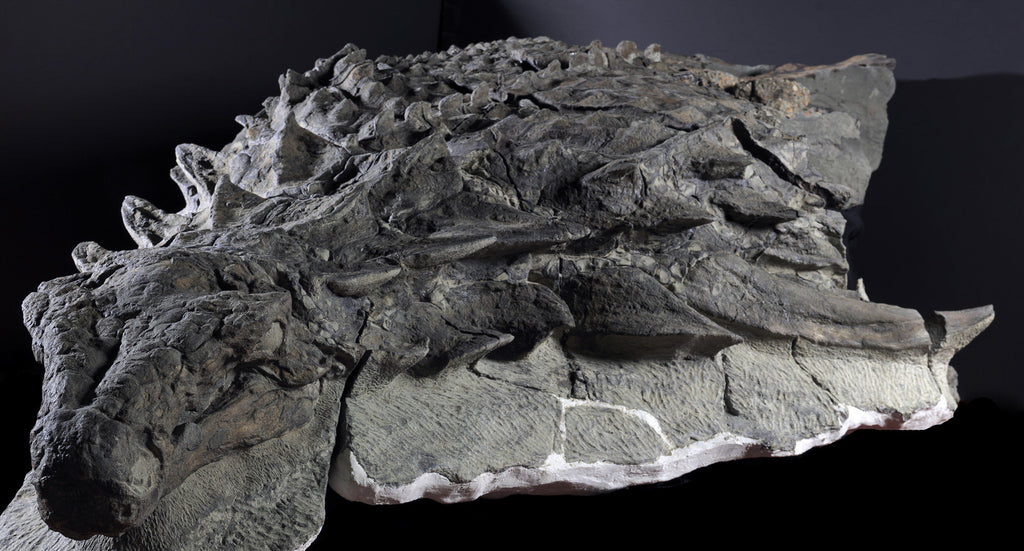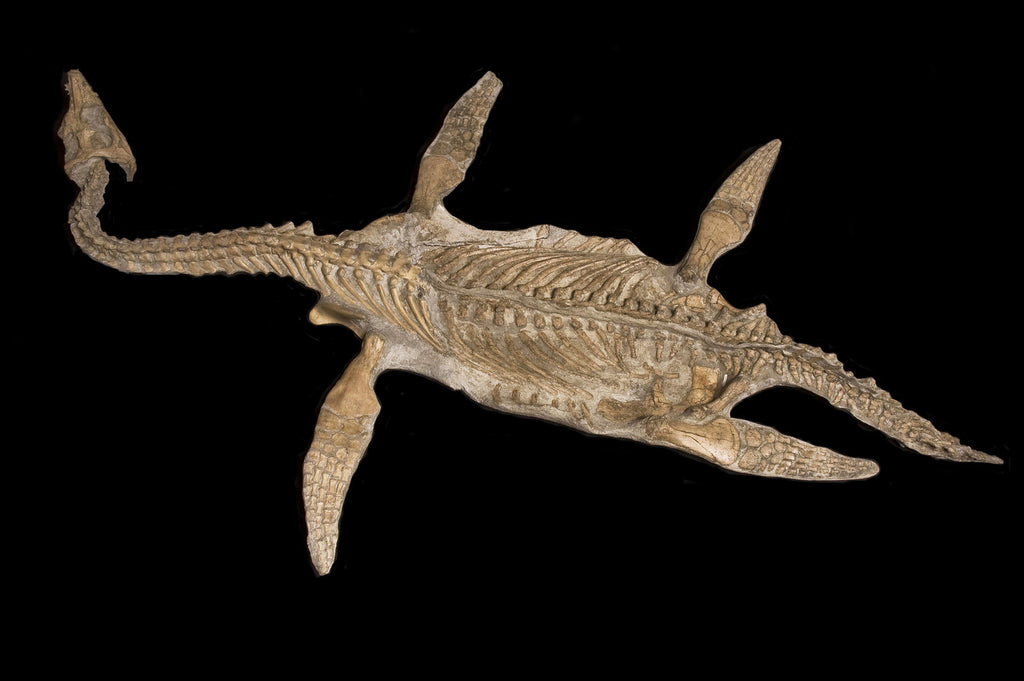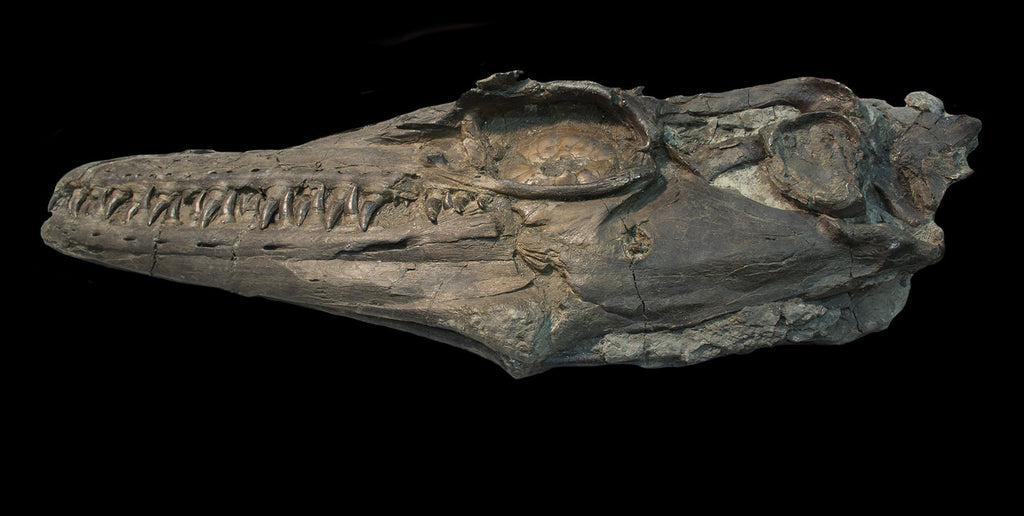The Royal Tyrrell Museum’s Innovative New Exhibit: Grounds for Discovery
The Royal Tyrrell Museum in Drumheller, Alberta is one of the world's foremost palaeontology museums. Its exciting new exhibit, Grounds for Discovery, showcases many marvellous fossil specimens that were discovered accidentally through industrial activity, such as mining or road-building. The exhibit is a testament to Alberta’s collaborative relationships between palaeontologists and major corporations, like the energy giants Suncor and Syncrude.
 This incredible Nodosaur fossil was discovered by a worker in the Suncor Millennium Mine in March 2011. It is the best preserved armoured dinosaur ever found. Image courtesy of the Royal Tyrrell Museum, Drumheller, Alberta.
This incredible Nodosaur fossil was discovered by a worker in the Suncor Millennium Mine in March 2011. It is the best preserved armoured dinosaur ever found. Image courtesy of the Royal Tyrrell Museum, Drumheller, Alberta.
We had the pleasure of discussing the unique premise behind the exhibit with Dr. Don Brinkman, the Royal Tyrrell Museum's Director of Preservation and Research. Dr. Brinkman also shared some fascinating stories behind the exhibit’s marquee fossils, including the now famous Nodosaur, a new genus and species of armoured dinosaur. The 110 million year old specimen is essentially mummified, with skin and and other soft tissue preserved - a practically unprecedented occurrence. He also gave us a glimpse of the museum's behind-the-scenes projects and excavations.
What was the idea behind the Grounds for Discovery exhibit?
There’s a number of things we wanted to do. Alberta has legislation that ensures that fossils that are encountered during any kind of industrial activity are preserved, and we wanted to show the success of this. We wanted to highlight some of the great specimens in our collection and we wanted to acknowledge some of the support we've got from industry that has resulted in preserving these specimens.
Do you hope to encourage more collaboration with industry through this exhibit?
Yeah, for sure. These are case studies that show how it's worked in the past, and by giving these examples we hope that people who are involved in industry who come see the museum will realize that we're not trying to shut down any operation. We're trying to ensure that any kind of significant fossils are preserved with minimum impact on the operation itself.
Are some companies reluctant to tell you about any fossils uncovered during their operations?
There's always that uncertainty when they've never worked with us, because they don't know what the potential impact on them will be. You always hear stories (whether they're true or not, you don't know) of industries not reporting things. Our best way of countering that is by working with them in a way that ensures that we don't have a major impact on them.
 A near-complete Plesiosaur (marine reptile) skeleton found at the Syncrude Canada Base Mine near Fort McMurray, Alberta in 1994. Image courtesy of the Royal Tyrrell Museum, Drumheller, Alberta.
A near-complete Plesiosaur (marine reptile) skeleton found at the Syncrude Canada Base Mine near Fort McMurray, Alberta in 1994. Image courtesy of the Royal Tyrrell Museum, Drumheller, Alberta.
I think it’s a great idea to work hand-in-hand with these companies.
We're always very conscious of that when we have reports. Our practice is basically to respond right away and work with them to make sure that we don't have [a negative] impact. This varies. There's some mines where fossils frequently come up and they've always been able to work in a different part of the mine while we collect the specimen. There was a specimen that was in the route of a pipeline and we were able to get right on it and get it out before they actually reached the point of installing the pipeline. We're conscious of the need to work cooperatively to preserve the specimens.
Would you say that more fossils are found accidentally through industrial activity than palaeontological surveying?
I'm not sure I'd say more, but they're found in places that you'd never find them during the normal course of surveys that we undertake. For example, northern Alberta is largely tree-covered and there's no way you're going to find fossils in that kind of setting. So the industrial activity that exposes the rock, and has led to finding fossils, gives us stuff that we never would have got otherwise.
Other than through mining and road construction, what types of commercial activity has led to the discovery of fossils in Alberta?
There's things that have come out of subdivision development in Calgary. Digging a basement of a house turned up this fantastic block with five fish scattered across the surface. There's stuff that comes out of quarries, gravel pits…[even] one instance of putting up a wind generating tower.
So fossil fish were found right in Calgary?
Yeah. It was found in a subdivision that was being developed in Calgary, just on the north part of the city. There's five skeletons of two different kinds of fish that are currently being described.
 Fossil fish block found while excavating a basement in the Evanston area of Calgary. This rare piece includes five fish of two newly discovered species. Image courtesy of the Royal Tyrrell Museum, Drumheller, Alberta.
Fossil fish block found while excavating a basement in the Evanston area of Calgary. This rare piece includes five fish of two newly discovered species. Image courtesy of the Royal Tyrrell Museum, Drumheller, Alberta.
Are there many fossils found through work in the oil sands?
Yeah. Marine reptiles…and the Nodosaur came out of the Suncor mine. These are in the beds over top of the oil sands themselves, so [the fossils] are essentially in the overburden they're digging through to get to the oil sands.
You mentioned the Nodosaur. What led to its amazing preservation?
A series of fortuitous events: an animal that got washed out to the ocean died and sank to the bottom without being scavenged, so there's no disturbance of it, and, apparently, no invertebrates scavenging on the carcass. So there probably was something in the chemistry of the environment that prevented the kind of scavengers that are almost ubiquitous on ocean floors.
It took over 7000 hours of work to prepare the fossil. Was that work done at the museum?
The specimen was brought back here. It was collected over the course of about three weeks. There was a huge investment from Suncor itself in terms of equipment and in terms of expediting it. One of the technicians [Mark Mitchell] worked on it as his major project over the past six years.
What sort of preparation was needed?
It was all mechanical preparation, basically chipping away the rock to expose the fossil. The challenging part of this was that, because it had the skin impression, it was tricky recognizing the layers when you got to them...it was very slow work, very detailed work.
Was the surrounding rock hard?
The bone itself is very soft, and the rock was hard, so that's a very difficult, challenging situation. You have to put a lot of force on the rock to remove the rock. But if you put force on the bone, it'll destroy the bone.
Well, the end result was remarkable! Another one of the fossils in the exhibit that’s quite unique is a primitive mammal called a Pantodont.
That was collected in road construction outside of Red Deer. There is a good record of the time right after the dinosaurs and this is from that early stage of the evolution of mammals. Most of the material from that time are isolated teeth, or maybe jaws with teeth, so this was exceptional in being part of a skeleton.
 Fossil skull of a Pantodont, an unusual prehistoric mammal that lived 60 million years ago. Although it possessed large canines, it was a herbivore. The specimen was found during road-construction east of Red Deer. Image courtesy of the Royal Tyrrell Museum, Drumheller, Alberta.
Fossil skull of a Pantodont, an unusual prehistoric mammal that lived 60 million years ago. Although it possessed large canines, it was a herbivore. The specimen was found during road-construction east of Red Deer. Image courtesy of the Royal Tyrrell Museum, Drumheller, Alberta.
Can you describe another standout fossil in the exhibit?
Another great fossil is the complete skeleton of a mosasaur, a giant marine lizard from the Late Cretaceous. That one was found in a mine in southern Alberta and one of the exceptional things about it is that it had been in a fight with another mosasaur - the other mosasaur had bitten it. A tooth had broken off in the jaw and the broken tooth is preserved in the skull. We know it happened when it was alive because there's absorption of a bone around it, so it got infected. We know from the tooth it's from the same kind of mosasaur, so it's direct evidence for intra-species fighting.
 This Mosasaur (marine reptile) skull is part of a skeleton that spans 6.5 meters (21 feet). Remarkably, the tooth of a rival mosasaur is embedded under its eye. It was found in the Korite Ammolite mine. Image courtesy of the Royal Tyrrell Museum, Drumheller, Alberta.
This Mosasaur (marine reptile) skull is part of a skeleton that spans 6.5 meters (21 feet). Remarkably, the tooth of a rival mosasaur is embedded under its eye. It was found in the Korite Ammolite mine. Image courtesy of the Royal Tyrrell Museum, Drumheller, Alberta.
Another major fossil on display is the dinosaur trackways. Are there many trackways in Alberta?
They're in the mines in the Grande Cache area, the mines in the western part of the province. They were formed on very broad, flat surfaces next to the ocean and the coal overlaps the beds the dinosaurs walked on, so in the mines in that area there's abundant tracks preserved.
In this particular specimen they’re form theropod dinosaurs, right?
We don't know what kind of theropod it is, but [it’s] a bipedal, meat-eating dinosaur with three toes on its feet. In the Late Cretaceous, Albertosaurus is an example of that kind of dinosaur. These are earlier than Albertosaurus, so we don't know exactly what kind.
 Theropod dinosaur trackway (mold). The original tracks are located in the Grande Cache Coal Mine in west-central Alberta. Image courtesy of the Royal Tyrrell Museum, Drumheller, Alberta.
Theropod dinosaur trackway (mold). The original tracks are located in the Grande Cache Coal Mine in west-central Alberta. Image courtesy of the Royal Tyrrell Museum, Drumheller, Alberta.
Does the exhibit feature any smaller fossils?
We've tried to show a diversity of the large and small things that have been found in the same kind of way [industrial activity]. There's a number of invertebrate fossils, ammonites in particular. Ammonites are an extinct group related to the squid, octopus and nautilus - they've got a coiled shell like the nautilus, divided into chambers.
The iridescent ammonites on display are particularly beautiful! In general, why is Alberta so fossil-rich?
Partly the environment is right, at least during the time of the dinosaurs. It was very low, so there's sediments being deposited and it was a combination, depending on the time, of either shallow marine or terrestrial sediments, so there was an abundance of animals available for fossilization. The sedimentation rates were relatively high, so that things were getting buried - and staying buried - to become fossils.
 Palaeontologist Don Brinkman working on a fossilized turtle in Dinosaur Provincial Park, near Patricia, Alberta. Image courtesy of the Royal Tyrrell Museum, Drumheller, Alberta.
Palaeontologist Don Brinkman working on a fossilized turtle in Dinosaur Provincial Park, near Patricia, Alberta. Image courtesy of the Royal Tyrrell Museum, Drumheller, Alberta.
It’s definitely a special place for palaeontology. Is there a lot of activity behind the scenes at the museum?
One of the neat things that's happened over the last few years is that we've had some people survey rivers that were affected by the floods of four years ago…the Highwood and the Bow, and some of the rivers in Southern Alberta. [We’ve] been finding some very significant specimens in areas that have been poorly known. Some of these are under research now and we hope to have them on exhibit in another year or so.
So the specimens were found because of the flooding?
Some of them, definitely. Some of them we probably could have found before but have never looked in those areas, and there's some that we know were exposed by the flooding.
Can you describe another ongoing project?
We have a quarry excavation of a duckbill dinosaur just outside Drumheller that's ongoing. It's an Edmontosaurus and it looks to be a fairly well-preserved skeleton. The tail is missing, but other than that it looks pretty complete. We're confident the skull is there and we're optimistic that it's going to be very well-preserved.
That sounds incredible! And I’m sure there’s much more going on. I was wondering if the Drumheller area is still open to the public to hike through?
The museum is in Midland Provincial Park and there are other areas around Drumheller where the badlands are easily accessible. Horsethief Canyon is one of the stops just outside Drumheller and then the Hoodoos are on the east side.
Can people still see fossils out there?
They could. They certainly could.
That’s good to hear. Is there anything else you want to add about the exhibit or the museum?
Nope, just come and visit us!
_______________________________________________________________________________
This interview was conducted by Peter Lovisek on July 5, 2017. It has been edited and condensed.
The exhibit is now open and it runs for 3 years. For more details, visit the Royal Tyrrell Museum's official blog. To learn more about the fossils on display, view the fact sheet created by the Royal Tyrrell Museum. For more information on the Nodosaur fossil, including an interactive 3-D feature, see this National Geographic article.


Comments
Gilleke Kopamees said:
Really cool reading!!!
Miguel Veilleux said:
realy impressive !!!!!!!